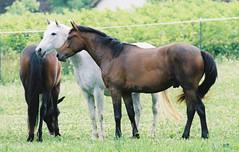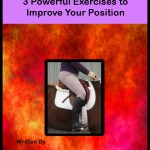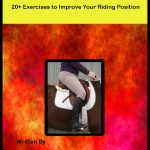Proven Methods to Fix Your Horse’s Head Tilt

I was teaching the other day and out of nowhere the student’s horse started to tip her head. You know the kind. One ear dips down and the horse’s muzzle slides out to the side.
If this happens to you keep reading because we can ‘fix’ that!
Symptoms of a Head Tilt
You will notice the horse dropping one ear and possibly dropping the contact on one side. It may begin as an evasion and show up when the horse is circling or performing lateral work. It may also appear on the long side or straight sides of your arena.
Cause of the Head Tilt
The most likely cause of the head tilt is stiffness through the horse’s poll. Other causes may be an injury or uncomfortable somewhere. To start, check all possible avenues of soreness:
- Teeth – wolf teeth can cause head tilt
- Bit – check to ensure the bit is sized correctly and the bit is not pinching
- Saddle Fit – unequal pressure or pinching of the saddle may result in a tippy head
- Soreness – we had a horse who had a bug-bite on her neck and as a result had a head tilt because it was painful for her to bend
Once you are satisfied there are no pain points causing the head tilt try this proved technique to correct the head tilt.
Correct the Head Tilt
To correct the head tilt start in the stable and do some light massages on the horse’s poll. Just behind the ears, massage the muscles gently. If your horse doesn’t approve of you touching his/her head there be patient and take your time. Just behind the horse’s ears you will feel two fleshy muscled ‘lumps’. Gently rub these with your thumb and finger. If these are hard and tense, then this may be where the head tilt is coming from.
Keep massaging until the horse releases and puts his/her head down. This will help release some of the tension in his neck. You will notice these ‘lumps’ get soft when your horse puts his head down thus relieving some tension in his poll.
The ‘Carrot Stretch’. This easy stretch will help to relieve and improve mobility in the horse’s neck and poll.
- Stand your horse beside a wall or fence.
- Take a carrot and show your horse the carrot (assuming your horse likes carrots) and bring the carrot to the side of the horse near the horse’s elbow, then rib cage, then hip. This is a gradual process and may take several weeks for this suppleness to develop. This increases flexibility and range of motion of the horse.
Correct a Head Tilt While Riding
Correcting the head tilt is first done at the halt.
- Have the horse stand straight
- Flex the horse left
- Use an indirect rein and aim the horse’s forehead slightly to the left, say 1 inch.
- Do not move the horse’s neck.
- Keep the neck straight and move the horse’s head slightly to the left. I like to say put the “horse’s left nostril in front of his left shoulder”.
- Too much flexion may result in the horse moving his neck. This will result in softening the neck rather than the poll.
- Watch to see just the corner of their eye and nostril comes slightly to the left.
Be aware of too much flexion which will supple the horse’s neck and not their poll.
The indirect rein is a subtle aid which directly affects the poll of the horse. The rein acts from the horse’s mouth to your hand which acts back toward your opposite hip. That means to say, to supple the horse to the left, the rein acts from the horses left side of his mouth, through to your left hand which is acting toward your right hip.
This can be done easily by using your left hand in a turning action as if you were turning a key in the ignition of a car, twisting your wrist so your fingernails turn up toward the ceiling. Then turning the ‘ignition’ back off again.
Be careful not to:
- Cross your hand over the horse’s neck.
- Hold your horse’s head there. Turn, then release.
- Ask for too much flexion. This will engage the neck and we want to supple the horse’s poll.
After completing softening of the left hand side, soften the horse on the right hand side.
Once you understand how to soften and supple your horse at the halt proceed to walk then trot and canter. Do not rush or progress faster than the horse will allow. Your horse will show you what to do next. If he is supple and relaxed at the walk then proceed to trot. Then to canter once you have mastered the trot.
What has been your experience with horses tilting their head? What have you done to correct it?





 Try these three powerful exercises to get strengthen your position.
Try these three powerful exercises to get strengthen your position.

Hi Laura,
I came across your site as you have just linked to a couple of my posts in related articles, thank you.
Love what you are doing, I work in the same lines, educating riders so they are better equipped to train their horses.
All the best,
Wiola
http://www.aspire-equestrian.com
Thank you Wiola for your comments.
I appreciate you and what you are doing to educate riders and horses to be the best they can be in the most natural way.
Hello, I live in the UK and came across your web site.
What it is, my mare which I have owned for 8 years, she is 11 now, well we did everything together, dressage, SJ, XC, hacking all at very low level but she is my best friend and she will try her hardest in everything we do.
2 years ago she started one day to tilt her head badly on right rein and not want to go forwards, so I thought teeth, she had dentist and seemed fine just routine rasp, still no better, so I tried her in every bit possible, she was worse in straight metal bits and better in rubber bits, I also rode her in a hackamore, she was terrible in this, so got her a dr cook bridle, much better but still tilting and not able to jump, so had back lady she said could be her neck so had few sessions with her under sedation, this made her worse. So then had neck and poll x-rays- slight arthritis through C6 I think and nuclear ligament!! So they injected with steroids, still no change.
So she went for bone scan- they found mild kissing spines and slight change in back right fetlock!! But the worse was her right side of her face ( it was glowing!!) so they x-rayed her jaw, they said she had a deep root infection in one of her molars so they removed it ( 5 hours it took and £2000!!) so she was on a few weeks rest and lots of bute.
I started riding her and WOW she was better, well that’s what I thought, but after a few rides she started to tilt again, not go forwards and if jumped her when landing she would throw her head up.
Ok no money left on insurance now for anything to do with head.
So opened new claim for kissing spines, the vets injected her back with steroids, no change!!!
So got acupuncturist out, he found pain in her hyoid bone!!!
She had 6 sessions with him, first one she got worse but after that she was amazing she had so much energy, but still not accepting a bit and still head tilting in the DR Cook bridle.
She was jumping much better now, so decided to go jumping with the DR cook bridle on, she was fine in the warm up on a soft arena, but the main class was on hard ground(middle of summer) she couldn’t do it, she did try her best but couldn’t handle the landing so I gave up, came out and popped her over the warm up again and she was fine.
Got home and really didn’t know what to do, she has had chiropractor, physio , cranial, acupuncture, 6 dentists, x rays, bone scan, injections.
For some reason I keep thinking it’s in her mouth.
I tried a homemade bit, I got her metal one and covered it in a leather shammy and soaked it in water, I rode her in this and she went amazing.
But she kept chewing the leather off so I bought some latex bit guard and wrapped that round and she now has that all the time, so I can now wear a bit, she does still head tilt but not as much.
I was taking her bridle off and noticed she really liked her TMJ nerves massaged and if pressed she would freak out!! So rung the vet and asked for her TMJ to be x rayed, so they did and also ultra-sounded it, it showed that her right side what all calcified and left side was fine, so they injected her right side and said give her 10 days off.
10th day tacked her up and got on, she was totally different, forward going and jumping very happily. And 90% head tilt gone, only thing is only lasted 2 months, she started to go back to her old ways, so I got it injected again 4 weeks ago, went jumping 2 days ago and won both classes, but she is already showing pain again, won’t stay in right canter, can’t really bend right.
Do you have any ideas????